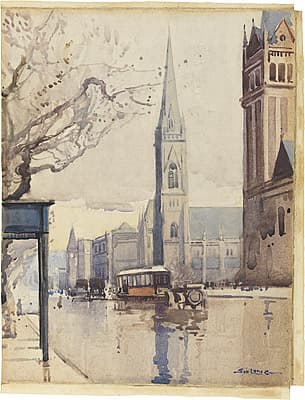
Sydney
LONG
Australia
1871
–
London
1955
England, Europe 1910-21; Australia 1921- 22; England 1922-25; Australia 1925-52; England from 1952
37.2 (h) x 28.8 (w) cm
signed ‘SID LONG’ lower right Queensland Art Gallery, Brisbane, bequest of George Brown 1977
This watercolour, one of only two Melbourne images by Long, is a westward view of Collins Street, near the corner of Russell Street, just down from the old Oriental Hotel. Scots' Church and the distinctive tower of Joseph Reed’s Congregational Church can be seen opposite. Further down is the clock tower of the Town Hall. On the road, cars and a Melbourne cable tram (operating between 1885–1940 in one of the largest systems in the world) are reflected on the wet road; these, the bleak sky and a bare plane tree point to a damp, late Autumn day. On the near side is the optician Alfred Nott’s decorative cast iron portico, one of a number that graced the street before the destructive post-war demolitions of the 1950s and 1960s.
The view is roughly opposite from where Charles Conder painted How we lost poor Flossie 1889 (AGSA). Collins, Australia’s premier street and the 19th-century artistic hub of the city, was a favoured subject for painters such as Ugo Catani, Tom Roberts, Clarice Beckett, Dora Wilson and John Brack, printmakers like John Shirlow and Eveline Syme and photographers such as Max Dupain.
Long first visited Melbourne in September 1910, while travelling on the SS Runic, en route to London. He spent a brief time there again in May 1921 on his return trip to Australia on the SS Calulu. Later that year, from 15 to 26 August, he held an exhibition in Melbourne at Decoration Galleries in Collins Street, The water-colours and etchings of Sydney Long, ARE, which included a work, Flinders Street (1). It is assumed that this Collins Street watercolour is a companion to Flinders Street, and that both were painted during Long’s brief stay in Melbourne in May 1921.
John Jones
This watercolour, one of only two Melbourne images by Long, is a westward view of Collins Street, near the corner of Russell Street, just down from the old Oriental Hotel. Scots' Church and the distinctive tower of Joseph Reed’s Congregational Church can be seen opposite. Further down is the clock tower of the Town Hall. On the road, cars and a Melbourne cable tram (operating between 1885–1940 in one of the largest systems in the world) are reflected on the wet road; these, the bleak sky and a bare plane tree point to a damp, late Autumn day. On the near side is the optician Alfred Nott’s decorative cast iron portico, one of a number that graced the street before the destructive post-war demolitions of the 1950s and 1960s.
The view is roughly opposite from where Charles Conder painted How we lost poor Flossie 1889 (AGSA). Collins, Australia’s premier street and the 19th-century artistic hub of the city, was a favoured subject for painters such as Ugo Catani, Tom Roberts, Clarice Beckett, Dora Wilson and John Brack, printmakers like John Shirlow and Eveline Syme and photographers such as Max Dupain.
Long first visited Melbourne in September 1910, while travelling on the SS Runic, en route to London. He spent a brief time there again in May 1921 on his return trip to Australia on the SS Calulu. Later that year, from 15 to 26 August, he held an exhibition in Melbourne at Decoration Galleries in Collins Street, The water-colours and etchings of Sydney Long, ARE, which included a work, Flinders Street (1). It is assumed that this Collins Street watercolour is a companion to Flinders Street, and that both were painted during Long’s brief stay in Melbourne in May 1921.
John Jones
This watercolour, one of only two Melbourne images by Long, is a westward view of Collins Street, near the corner of Russell Street, just down from the old Oriental Hotel. Scots' Church and the distinctive tower of Joseph Reed’s Congregational Church can be seen opposite. Further down is the clock tower of the Town Hall. On the road, cars and a Melbourne cable tram (operating between 1885–1940 in one of the largest systems in the world) are reflected on the wet road; these, the bleak sky and a bare plane tree point to a damp, late Autumn day. On the near side is the optician Alfred Nott’s decorative cast iron portico, one of a number that graced the street before the destructive post-war demolitions of the 1950s and 1960s.
The view is roughly opposite from where Charles Conder painted How we lost poor Flossie 1889 (AGSA). Collins, Australia’s premier street and the 19th-century artistic hub of the city, was a favoured subject for painters such as Ugo Catani, Tom Roberts, Clarice Beckett, Dora Wilson and John Brack, printmakers like John Shirlow and Eveline Syme and photographers such as Max Dupain.
Long first visited Melbourne in September 1910, while travelling on the SS Runic, en route to London. He spent a brief time there again in May 1921 on his return trip to Australia on the SS Calulu. Later that year, from 15 to 26 August, he held an exhibition in Melbourne at Decoration Galleries in Collins Street, The water-colours and etchings of Sydney Long, ARE, which included a work, Flinders Street (1). It is assumed that this Collins Street watercolour is a companion to Flinders Street, and that both were painted during Long’s brief stay in Melbourne in May 1921.
John Jones
